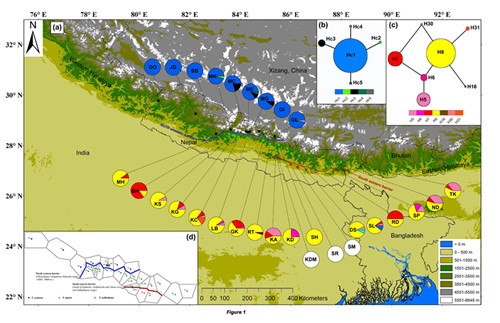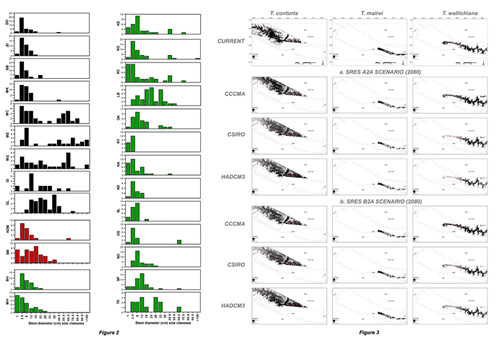
Concerted Conservation Efforts are Necessary to Conserve Yews of the Himalayas
Aug 20, 2014 Email"> PrintText Size

Species of Taxus (yews) are reputed for the anticancer compound paclitaxel. Excessive harvesting triggered by commercial exploitation for the production of anticancer drugs and in some areas intense local use for timber and other purposes has cleared several of natural yew populations in the Himalayas and SW China. Awareness and concern have been raised for years at the local, national and international levels to conserve the remaining wild populations of yews. For a decade, Prof. LI Dezhu’s group at Kunming Institute of Botany (KIB) has undertaken several research projects to determine exact number of species and assess level of genetic diversity throughout species range incorporating several populations from South Asia including the Hindu Kush-Himalaya region.
Under the supervision of Profs. LI Dezhu, GAO Lianming and Dr. Michael Moller, a former PhD student of KIB, Dr. Ram C. Poudel, together with Dr. LIU Jie has recently published their research findings in a journal of conservation biology Diversity and Distributions. In all the allopatrically distributed species of central Himalaya viz. Taxus contorta, T. mairei and T. wallichiana, Dr. Poudel and colleagues have used a multidisciplinary approach combining a transect study, population genetic analyses based on chloroplast DNA sequences and nuclear microsatellite data, and ecological modelling to estimate the size-class structure, genetic diversity and differentiation of populations and understand the potential fate of yew populations in the face of rapidly degrading habitats and abrupt climate change.
For all three species, the flat regression slopes of the size-class distributions (SCD), and high permutation index values indicate unstable population structure with lower recruitment rates (Figure 2 left). The chloroplast and nuclear microsatellite data further reveal low genetic diversity, significant population differentiation and high inbreeding for yew species of this region. Two strong barriers of genetic discontinuities have been identified, where the presence of spatially different ecological environments caused an allopatric distribution of the species (Figure 1). The ecological model projection for the year 2080 forecasted a substantial decrease in size of suitable areas and a range shift towards the north (Figure 2 right).
The spatial distribution of the genetic variation and diversity within and among the populations of each yew species was largely shaped by their peripheral position in their respective ranges, differences in their evolutionary histories, and the periodic and asynchronous climates experienced by the species, in addition to the severe impacts of anthropogenic activities. Several yew populations in Central Himalaya have already declined to sizes too small to be demographically sustainable. Concerted conservation strategies have been thoroughly discussed to conserve and manage sustainably the highly threatened yew populations in the Himalayas both at the species and landscape levels.
This study was supported by the National Key Basic Research Program of China (2014CB954100), the Key Research Program of the Chinese Academy of Sciences (KJZD-EW-L07), the National Natural Science Foundation of China (NSFC 31370252) and CAS/SAFEA International Partnership Program for Creative Research Teams.
This manuscript entitled "Low genetic diversity and high inbreeding of the endangered yews in Central Himalaya: implications for conservation of their highly fragmented populations" was published on Diversity and Distributions.

Figure 1. (a) Sampling locations and distribution frequencies of cpDNA haplotypes of Taxus contorta (top, black circles), T. mairei (bottom centre, red circles) and T. wallichiana (bottom, green circles). The top right insets depict median joining phylogenetic networks among haplotypes of (b) T. contorta and (c) T. wallichiana. The bottom left insect (d) presents the result of the BARRIER analysis. The northern barrier (blue colored line) separates the western Himalayan species Taxus contorta (from left to top center) from the eastern Himalayan species T. wallichiana (from right to middle center). The southern barrier (red colored line) separates T. wallichiana from T. mairei (in the south). Light grey lines: Delaunay triangulation. Blue and red dotted lines at the center of the map represent northwestern and southeastern barriers respectively. (Image by KIB)

Figure 2. Diameter at breast height (DBH) size-class distribution of each transect of Taxus contorta (black bars), T. mairei (red bars) and T. wallichiana (green bars) (Left). Current and future projection (year 2080) of potentially suitable habitats under (a) A2A and (b) B2A IPCC Special Report on Emission Scenarios (SRES) and three different Global Climate Models for Taxus contorta, T. mairei and T. wallichiana respectively (Right). (Image by KIB)
Species of Taxus (yews) are reputed for the anticancer compound paclitaxel. Excessive harvesting triggered by commercial exploitation for the production of anticancer drugs and in some areas intense local use for timber and other purposes has cleared several of natural yew populations in the Himalayas and SW China. Awareness and concern have been raised for years at the local, national and international levels to conserve the remaining wild populations of yews. For a decade, Prof. LI Dezhu’s group at Kunming Institute of Botany (KIB) has undertaken several research projects to determine exact number of species and assess level of genetic diversity throughout species range incorporating several populations from South Asia including the Hindu Kush-Himalaya region.
Under the supervision of Profs. LI Dezhu, GAO Lianming and Dr. Michael Moller, a former PhD student of KIB, Dr. Ram C. Poudel, together with Dr. LIU Jie has recently published their research findings in a journal of conservation biology Diversity and Distributions. In all the allopatrically distributed species of central Himalaya viz. Taxus contorta, T. mairei and T. wallichiana, Dr. Poudel and colleagues have used a multidisciplinary approach combining a transect study, population genetic analyses based on chloroplast DNA sequences and nuclear microsatellite data, and ecological modelling to estimate the size-class structure, genetic diversity and differentiation of populations and understand the potential fate of yew populations in the face of rapidly degrading habitats and abrupt climate change.
For all three species, the flat regression slopes of the size-class distributions (SCD), and high permutation index values indicate unstable population structure with lower recruitment rates (Figure 2 left). The chloroplast and nuclear microsatellite data further reveal low genetic diversity, significant population differentiation and high inbreeding for yew species of this region. Two strong barriers of genetic discontinuities have been identified, where the presence of spatially different ecological environments caused an allopatric distribution of the species (Figure 1). The ecological model projection for the year 2080 forecasted a substantial decrease in size of suitable areas and a range shift towards the north (Figure 2 right).
The spatial distribution of the genetic variation and diversity within and among the populations of each yew species was largely shaped by their peripheral position in their respective ranges, differences in their evolutionary histories, and the periodic and asynchronous climates experienced by the species, in addition to the severe impacts of anthropogenic activities. Several yew populations in Central Himalaya have already declined to sizes too small to be demographically sustainable. Concerted conservation strategies have been thoroughly discussed to conserve and manage sustainably the highly threatened yew populations in the Himalayas both at the species and landscape levels.
This study was supported by the National Key Basic Research Program of China (2014CB954100), the Key Research Program of the Chinese Academy of Sciences (KJZD-EW-L07), the National Natural Science Foundation of China (NSFC 31370252) and CAS/SAFEA International Partnership Program for Creative Research Teams.
This manuscript entitled "Low genetic diversity and high inbreeding of the endangered yews in Central Himalaya: implications for conservation of their highly fragmented populations" was published on Diversity and Distributions.

Figure 1. (a) Sampling locations and distribution frequencies of cpDNA haplotypes of Taxus contorta (top, black circles), T. mairei (bottom centre, red circles) and T. wallichiana (bottom, green circles). The top right insets depict median joining phylogenetic networks among haplotypes of (b) T. contorta and (c) T. wallichiana. The bottom left insect (d) presents the result of the BARRIER analysis. The northern barrier (blue colored line) separates the western Himalayan species Taxus contorta (from left to top center) from the eastern Himalayan species T. wallichiana (from right to middle center). The southern barrier (red colored line) separates T. wallichiana from T. mairei (in the south). Light grey lines: Delaunay triangulation. Blue and red dotted lines at the center of the map represent northwestern and southeastern barriers respectively. (Image by KIB)

Figure 2. Diameter at breast height (DBH) size-class distribution of each transect of Taxus contorta (black bars), T. mairei (red bars) and T. wallichiana (green bars) (Left). Current and future projection (year 2080) of potentially suitable habitats under (a) A2A and (b) B2A IPCC Special Report on Emission Scenarios (SRES) and three different Global Climate Models for Taxus contorta, T. mairei and T. wallichiana respectively (Right). (Image by KIB)
CAS Institutes
There are 124 Institutions directly under the CAS by the end of 2012, with 104 research institutes, five universities & supporting organizations, 12 management organizations that consist of the headquarters and branches, and three other units. Moreover, there are 25 legal entities affiliated and 22 CAS invested holding enterprisesThere are 124 I...>> more
Contact Us

Chinese Academy of Sciences
Add: 52 Sanlihe Rd., Xicheng District, Beijing, China
Postcode: 100864
Tel: 86-10-68597592 (day) 86-10-68597289 (night)
Fax: 86-10-68511095 (day) 86-10-68512458 (night)
E-mail: cas_en@cas.cn

